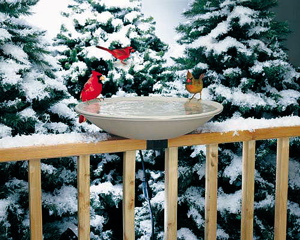-
heated bird baths…well worth the effort!
Frigid winters can be a tough time for wildlife…survival of the fittest is nature’s rule.
Not only do natural food sources dwindle, but shallow pools and ponds tend to freeze, leaving birds and other wildlife without a consistent water source. Some folks believe birds can just east snow to get water, and in part that’s true. But it takes them a tremendous amount of energy to actually convert the snow to water. Energy that could be better spent on staying warm. Birds, like other beings, obtain energy from calories, so this process ends up being a terrible waste of precious calories for wild birds’ metabolisms.
Offering heated bird baths will encourage some species to over-winter in your yard and immediate area. Bluebirds especially, will stick around if heated bath water is readily available. Ground baths are also a great idea, because birds’ naturally bathe at ground level. These heated bird baths can also be quite enticing for other wildlife too.
Innovative birdbath heaters will allow you to convert your favorite bath into a heated one. New materials that are safe for all types of birdbaths make it simple to do so. Even resin, or plastic baths can utilize these heaters, there are heated mats, resin-cased heaters and the very cool Heated Rock.
This winter, consider adding heated bird baths to your landscape, or purchasing a bath heater for your existing birdbath. You’ll help feathered friends thrive and flourish during frigid temperatures, plus catch some quality bird-watching time!
-
Heated Bird Baths Allow Some Birds to Over-Winter
With the end of summer, so comes the migration south for many song birds. A few favorites may stick around if their habitat suits them well enough. Bluebirds in my yard for example, surprised me last year when they decided to over-winter. Probably because of the juicy live worms they were offered everyday, and mostly because of the heated bird baths in the yard. This season we had three successful broods!
Heated bird baths really are important to wild birds. As temperatures drop and local water sources tend to freeze over, the baths offer an oasis for drinking and bathing. Clean feathers are a must for birds to stay warm too. When you see them “puff up” it is a mechanism they use to retain body heat. Some folks believe birds can eat snow for water, and they can, but it takes them many calories to convert the snow to water. And these are precious calories needed to just stay warm.
If you already have a favorite bath, please don’t empty it and turn it over for winter. Consider adding a heater or deicer to it for the birds. They need fresh water in winter just as much as hot summ
er months. Many of the newer heaters are safe for use with all bird baths, so there’s no worry about having a metal heater in a plastic or resin bath. The Heated Rock for example, is an innovative new heater that’s safe with all types of baths. Mat-type heaters can be used with all baths as well.
Help birds to thrive and flourish this winter by offering a consistent fresh water source with heated bird baths. You never know who may surprise you and decide to stick around?
-
Heated Bird Baths Do The Trick!
An investment in a birdbath is well worth the visitors it will bring to your yard. If you’re thinking of a new one to replace the old chipped concrete one …or even your first one…consider heated bird baths if your winters are freezing. Just as important in sweltering summer heat, a constant fresh water source is crucial to birds when temperatures freeze. Many folks believe birds eat snow for water (and they can) but it’s very difficult for them to metabolize and burns precious calories needed to stay warm. Shallow ponds will also tend to freeze over when temperatures drop below 32 degrees, and this renders a consistent and reliable water source useless for birds.
Remember, the heater does not need to run to use the bath year-round. In our yard there are 3 heated bird baths running throughout winter. This is part of the reason our bluebirds stuck around all year. Likely it was the live meal worms that were the big attraction, but these baths ensured fresh water daily regardless of the weather.





